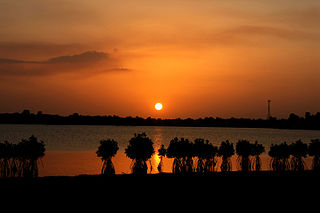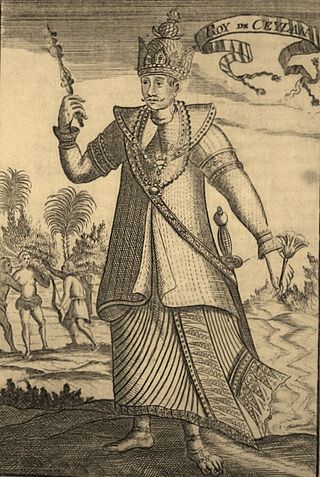
This is a demography of the population of Sri Lanka including population density, ethnicity, education level, health of the population, economic status, religious affiliations and other aspects of the population.

Portuguese creoles are creole languages which have Portuguese as their substantial lexifier. The most widely-spoken creoles influenced by Portuguese are Cape Verdean Creole, Guinea-Bissau Creole and Papiamento.

Islam is the third largest religion in Sri Lanka, with about 9.7 percent of the total population following the religion. About 1.9 million Sri Lankans adhere to Islam as per the Sri Lanka census of 2012. The majority of Muslims in Sri Lanka are concentrated in the Eastern Province of the island. Other areas containing significant Muslim minorities include the Western, Northwestern, North Central, Central and Sabaragamuwa provinces. Muslims form a large segment of the urban population of Sri Lanka and are mostly concentrated in major cities and large towns in Sri Lanka, like Colombo. Most Sri Lankan Muslims primarily speak Tamil, though it is not uncommon for Sri Lankan Muslims to be fluent in Sinhalese. The Sri Lankan Malays speak the Sri Lankan Malay creole language in addition to Sinhalese and Tamil.

Batticaloa is a major city in the Eastern Province, Sri Lanka, and its former capital. It is the administrative capital of the Batticaloa District. The city is the seat of the Eastern University of Sri Lanka and is a major commercial centre. It is on the east coast, 111 kilometres (69 mi) south of Trincomalee, and is situated on an island. Pasikudah is a popular tourist destination situated 35 km (22 mi) northwest with beaches and flat year-round warm-water shallow-lagoons.
Burgher people, also known simply as Burghers, are a small Eurasian ethnic group in Sri Lanka descended from Portuguese, Dutch, British and other Europeans who settled in Ceylon. The Portuguese and Dutch had held some of the maritime provinces of the island for centuries before the advent of the British Empire. With the establishment of Ceylon as a crown colony at the end of the 18th century, most of those who retained close ties with the Netherlands departed. However, a significant community of Burghers remained and largely adopted the English language. During British rule, they occupied a highly important place in Sri Lankan social and economic life.
Sri Lanka Indo-Portuguese, Ceylonese Portuguese Creole or Sri Lankan Portuguese Creole (SLPC) is a language spoken in Sri Lanka. While the predominant languages of the island are Sinhala and Tamil, the interaction of the Portuguese and the Sri Lankans led to the evolution of a new language, Sri Lanka Portuguese Creole (SLPC), which flourished as a lingua franca on the island for over 350 years (16th to mid-19th centuries). SLPC continues to be spoken by an unknown number of Sri Lankans, estimated to be extremely small.

The Eastern Province is one of the nine provinces of Sri Lanka, the first level administrative division of the country. The provinces have existed since the 19th century but did not have any legal status until 1987 when the 13th Amendment to the Constitution of Sri Lanka established provincial councils. Between 1988 and 2006 the province was temporarily merged with the Northern Province to form the North Eastern Province. The capital of the province is Trincomalee. Kalmunai is the largest and most populous city of Eastern Province.
The Portuguese Burghers are an ethnic group in Sri Lanka, of mixed Portuguese and Sri Lankan descent. They are largely Roman Catholic and some still speak the Sri Lanka Indo-Portuguese language, a creole based on Portuguese mixed with Sinhalese. In modern times, English has become the common language while Sinhalese is taught in school as a second language. Portuguese Burghers sometimes mixed with but are to be distinguished from other Burgher people, such as Dutch Burghers.
The Sri Lankan Kaffirs are an ethnic group in Sri Lanka who are partially descended from 16th-century Portuguese traders and Bantu slaves who were brought by them to work as labourers and soldiers to fight against the Sinhala kings. They are very similar to the Zanj-descended populations in Iraq and Kuwait, and are known in Pakistan as Sheedis and in India as Siddis. The Kaffirs spoke a distinctive creole based on Portuguese, and the "Sri Lankan Kaffir language". Their cultural heritage includes the dance styles Kaffringna and Manja and their popular form of dance music Baila.
The Sri Lanka Portuguese Creole Manuscript is a significant record of the Sri Lankan Indo-Portuguese creole, as spoken in the 19th century among the Burgher and Kaffir communities. It a precious source for linguistic, literary, anthropological, and folkloric studies.

Kompagngna Veediya also known as Kampong Kertel and Kompanna Veediya, formerly known as Slave Island, is a suburb in Colombo, Sri Lanka, located directly south of the Fort. The suburb contains Beira Lake, a large lake and its esplanade is visited by many for recreation. Company Roads is mostly a commercial area with hotels, shopping centres, street food stalls, and is known for its multicultural, especially Malay heritage.
Seyed Ali Zahir Moulana is a Sri Lankan politician, former diplomat and local government activist. He is most known for the pivotal and important role he played in bringing about an end to the Sri Lankan Civil War.

Nalanda College is a leading Buddhist school in Sri Lanka where provides primary and secondary education for Sri Lankan boys. The school was established by P. de S. Kularatne as an offshoot of Ananda College Colombo and was registered as a separate school on 1 November 1924.

Vimaladharmasūriya I was a king of Kandy from 1590 to 1604. His reputation was built when he successfully repulsed two major Portuguese offensives on Kandy, the Battle of Danture in 1594 and the Battle of Balana in 1602, in both of which the Portuguese were humiliatingly defeated.
The Battle of Randeniwela was fought on 25 August 1630 in the Sinhalese–Portuguese War. It was fought between Portuguese Empire and King Senarth's youngest son Prince Maha Astana, who would later become Rajasinghe II against Portuguese forces commanded by then Governor Constantinu De Sá de Noronha. It was fought at Randeniwela near Wellawaya, a place close to the town of Badulla. The battle broke off when Constantino de Sá launched the invasion via Badulla. The Portuguese army suffered a complete rout subsequent to a mass defection by its Lascarin contingent.

Vishvanath Buddhika Keerthisena, also known as Boodee Keerthisena, is a Sri Lankan filmmaker. He began his career drawing comics before moving into painting, dress design, and visual arts. He moved into music in the late 1980s, and performed in a band called "Boo-Dee and the Woo-Zees" (1986–1992) as the lead singer.

Afro-Asians are African communities that have been living in the Indian subcontinent for centuries and have settled in countries such as India, Pakistan, and Sri Lanka.
Handapangoda Mudalige Chandrapala Gunasekera was a Sri Lankan politician who served as a Member of Parliament. He was the Deputy Minister of Culture and Social Services.
The H.A.I. Goonetileke Prize for Literary Translation is a bi-annual literary prize in Sri Lanka. It is awarded by the Gratiaen Trust, which also awards the Gratiaen Prize, for the translation of Sinhala or Tamil language creative writing into English. It was established in 2003.









